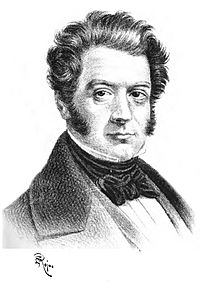Jorge Beauchef facts for kids
Quick facts for kids
Jorge Beauchef
|
|
|---|---|
 |
|
| Native name |
George Beauchef
|
| Born | 1787 Velay, France |
| Died | June 10, 1840 (aged 52-53) Santiago, Chile |
| Allegiance | |
| Battles/wars | War of the Third Coalition
Peninsular War
|
| Spouse(s) | Teresa Manso |
Jorge Beauchef (born in 1787 in Velay, France – died June 10, 1840, in Santiago, Chile) was a French soldier. He fought in the Napoleonic Wars in Europe. Later, he became famous in South America for his important role in the Chilean War of Independence.
Beauchef helped Chile gain its freedom from Spanish rule. He won many key battles, like the Battle of Maipú and the capture of Valdivia. The Battle of Maipú was especially important as it secured Chile's independence.
He is also known as a founder of the Chilean Navy. He worked closely with Lord Cochrane, a famous British naval officer. Together, they achieved the victory at Valdivia and were honored for it. Beauchef also served briefly as governor of Lima and helped in the Peruvian War of Independence.
Today, a street in downtown Santiago is named "Beauchef Street" in his honor. The main buildings of the University of Chile's science and math faculty are located there, known as "Campus Beauchef." A TV series about his life was released in 2006. His war stories have been published many times in different languages.
Contents
Beauchef's Adventures in South America
In 1808, Jorge Beauchef was captured in Spain. But he managed to escape and traveled to the United States. There, he was invited to join the South American patriots who were fighting for independence. He aimed to join the Army of the Andes but arrived too late for the important battle of Chacabuco.
Joining the Fight for Freedom
Once he arrived, Beauchef quickly joined the fight against the royalists (people loyal to Spain). He first took part in the siege of Talcahuano in 1817. Then, in 1818, he played a role in the major patriot victory at the Battle of Maipú. This battle was a huge step towards Chile's independence.
In 1819, Beauchef joined the new Chilean Navy. He served under the command of Lord Cochrane. In February 1820, Beauchef led a daring attack by sea and land on the strong forts of Corral Bay. This led to the successful capture of Valdivia.
After this victory, Beauchef stayed in Valdivia to chase away any remaining royalist forces. Lord Cochrane sailed further south to Chiloé Island. Beauchef then left Valdivia to drive the royalists out of Osorno. The royalist soldiers from Valdivia had fled to Osorno and then gathered at Carelmapu fort. They were ordered to fight Beauchef. In the Battle of El Toro in 1820, Beauchef successfully defeated them.
Later Missions and Challenges
In 1823, Beauchef was sent to Peru with extra soldiers to help José de San Martín's army. He served as governor of Lima for a short time. Back in Chile, he joined an expedition to Chiloé Island in 1824. However, his forces were defeated in the Battle of Mocopulli. Chiloé would only become part of Chile after another expedition in 1826.
Later Life and Passing
In 1828, Jorge Beauchef left the army. Three years later, in 1831, he visited his home country of France. He stayed there for two years before returning to Chile. He passed away in Santiago on June 10, 1840.
Beauchef's Lasting Legacy
In 1970, a statue was built in his honor in Valdivia. This statue celebrates his greatest victory, the capture of Valdivia in 1820. His bravery and leadership helped shape the history of Chile.
See also
 In Spanish: Jorge Beauchef para niños
In Spanish: Jorge Beauchef para niños

